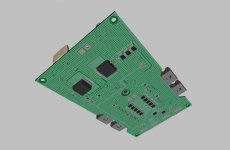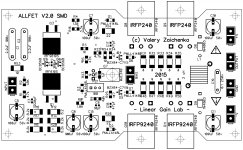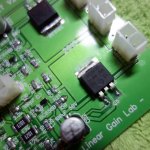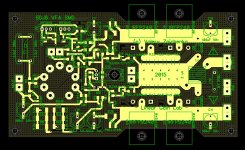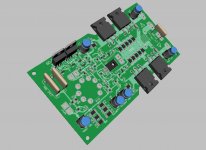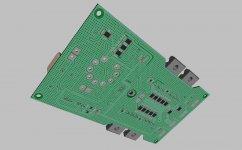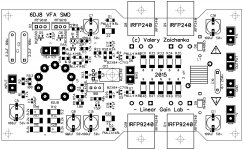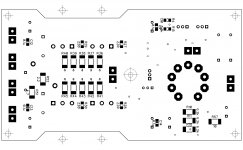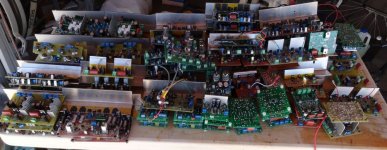ALLFET V2.0 - universal SMD / TH electrolytics
Here is an updated layout for ALLFET V2.0 - accepting either SMD or TH electrolytic caps, also a couple of minor improvements are introduced - please use this version for building.
Let me know if you'd like to have the gerbers.
Terry - already in your mail 😉
Cheers,
Valery
P.S. Output transistors and Vbe multiplier must be under the board - this is just the way DipTrace renders 3D 🙂
P.P.S. I recommend using 100uF/100V ones as TH version - just for more reliability. The placeholders are fine for them.
P.P.P.S. Tube version update will follow soon!
Here is an updated layout for ALLFET V2.0 - accepting either SMD or TH electrolytic caps, also a couple of minor improvements are introduced - please use this version for building.
Let me know if you'd like to have the gerbers.
Terry - already in your mail 😉
Cheers,
Valery
P.S. Output transistors and Vbe multiplier must be under the board - this is just the way DipTrace renders 3D 🙂
P.P.S. I recommend using 100uF/100V ones as TH version - just for more reliability. The placeholders are fine for them.
P.P.P.S. Tube version update will follow soon!
Attachments
Last edited:
Excellent work ,Val.
You will be the next "aussieamps".
You've gone beyond him with FET's in the IPS. (more radical designs)
His standard IPS is a pretty uniform BJT design with Bifet outputs.
Mostly SMD , as well.
PS - I saw the 2007-8 "aussieamp" "birth".😀
OS
You will be the next "aussieamps".
You've gone beyond him with FET's in the IPS. (more radical designs)
His standard IPS is a pretty uniform BJT design with Bifet outputs.
Mostly SMD , as well.
PS - I saw the 2007-8 "aussieamp" "birth".😀
OS
Thank you Pete 🙂
I really had fun with this one as well as with the tube hybrid version of it, trying to maintain the quality, preserving simplicity 😉 Individual characteristics of the devices allow good stability margins utilizing rather simple compensation - something I like a lot these days.
Cheers,
Val
I really had fun with this one as well as with the tube hybrid version of it, trying to maintain the quality, preserving simplicity 😉 Individual characteristics of the devices allow good stability margins utilizing rather simple compensation - something I like a lot these days.
Cheers,
Val
I noticed the 'checkered" ground plane.
I also noticed uncheckered trace areas in the higher current return areas.
Does this have any advantages over a traditional star return layout ?
Could not find much internet data concerning this technique.
OS
I also noticed uncheckered trace areas in the higher current return areas.
Does this have any advantages over a traditional star return layout ?
Could not find much internet data concerning this technique.
OS
I noticed the 'checkered" ground plane.
I also noticed uncheckered trace areas in the higher current return areas.
Does this have any advantages over a traditional star return layout ?
Could not find much internet data concerning this technique.
OS
I don't think I've ever seen Valery use a traditional star ground. I've never really had any noise issues with the ones I've built either. He's doing something right there.
Yes, I normally don't make it really a "star", but I try to stick to the rule of having only one route to the ground connection on the PCB.
On the other hand - ground plane is very convenient when you build an SMD layout - I have tested an all-over solid ground plane in CF-FET V2.0 SMD front-end with excellent results (on the picture). Well, that one goes to extreme, having a solid ground plane on both sides 🙂
The "checkered" one - a little bit lighter (not that important), but the main point - it requires less heat from the iron when soldering - the solid one is a good "heatsink" 😉
On the other hand - ground plane is very convenient when you build an SMD layout - I have tested an all-over solid ground plane in CF-FET V2.0 SMD front-end with excellent results (on the picture). Well, that one goes to extreme, having a solid ground plane on both sides 🙂
The "checkered" one - a little bit lighter (not that important), but the main point - it requires less heat from the iron when soldering - the solid one is a good "heatsink" 😉
Attachments
You can select thermal reliefs in the ground plane to make soldering easier.Yes, I normally don't make it really a "star", but I try to stick to the rule of having only one route to the ground connection on the PCB.
On the other hand - ground plane is very convenient when you build an SMD layout - I have tested an all-over solid ground plane in CF-FET V2.0 SMD front-end with excellent results (on the picture). Well, that one goes to extreme, having a solid ground plane on both sides 🙂
The "checkered" one - a little bit lighter (not that important), but the main point - it requires less heat from the iron when soldering - the solid one is a good "heatsink" 😉
You should be able to set the relief track width. For power components I use 25 thou.
Someone with a better memory will be able to say why you should remove unconnected islands.
Sent from my SM-N9005 using Tapatalk
Someone with a better memory will be able to say why you should remove unconnected islands.
Sent from my SM-N9005 using Tapatalk
You should be able to set the relief track width. For power components I use 25 thou.
Someone with a better memory will be able to say why you should remove unconnected islands.
Sent from my SM-N9005 using Tapatalk
Unconnected islands act like an antenna the same way a floating shield does on an interconnect cable.
6DJ8 VFA SMD - universal SMD / TH electrolytics
Updated the same way as an ALLFET V2.0 one.
Gerbers - PM please.
Cheers,
Valery
Updated the same way as an ALLFET V2.0 one.
Gerbers - PM please.
Cheers,
Valery
Attachments
Hi Valery,
Have you tested this circuit? Have you found that the ECC88 is better than the 12AU7?
Thanks, Terry
Have you tested this circuit? Have you found that the ECC88 is better than the 12AU7?
Thanks, Terry
I know I preferred the 12AU7 version of Borys' hybrid over the ECC88 version but that may be because I used the 6N1P tube. I still don't have any 6DJ8 tubes yet. I may change my mind once they arrive.
I'm contemplating ordering some boards but may wait until I see if there will be interest in the excess boards. I have a literal mountain of amps now.
I'm contemplating ordering some boards but may wait until I see if there will be interest in the excess boards. I have a literal mountain of amps now.
Attachments
Looks like you need to move a few boards as 'pre-built and tested' modules in the vendor's bazaar area to thin the herd a little.
Yes, I thought of that. Just not sure how to go about listing them. I would love for some folks to be able to make amps from them. Not sure how many folks want pre-built boards. I suppose some just enjoy the final stages. I actually enjoy that part too but I'm running out of room and the heatsink, PSU sections are expensive.
Blessings, Terry
Blessings, Terry
I know I preferred the 12AU7 version of Borys' hybrid over the ECC88 version but that may be because I used the 6N1P tube. I still don't have any 6DJ8 tubes yet. I may change my mind once they arrive.
I'm contemplating ordering some boards but may wait until I see if there will be interest in the excess boards. I have a literal mountain of amps now.
Did you ever try the industrial version -- 6922?
-RNM
You need to start laying out your own boards. That's half the fun and slows you down a lot.I know I preferred the 12AU7 version of Borys' hybrid over the ECC88 version but that may be because I used the 6N1P tube. I still don't have any 6DJ8 tubes yet. I may change my mind once they arrive.
I'm contemplating ordering some boards but may wait until I see if there will be interest in the excess boards. I have a literal mountain of amps now.
Did you ever try the industrial version -- 6922?
-RNM
No, so far I only tried the 6V1P in that circuit. I have some ECC88 on order. I will look into the 6922. All I know right now is that the IPS I built with the 12AU7 sounds better to me than the one I built with the 6N1P and is more stable. I don't know if it is the tube choice, or the differences in the circuit. I tried two separate tubes and they both gave the same results.
Yes, I bought Sprint 6.0 but I'm having trouble getting my head wrapped around it. I'm looking forward to learning it.You need to start laying out your own boards. That's half the fun and slows you down a lot.
- Status
- Not open for further replies.
- Home
- Amplifiers
- Solid State
- "Compact" VFA


